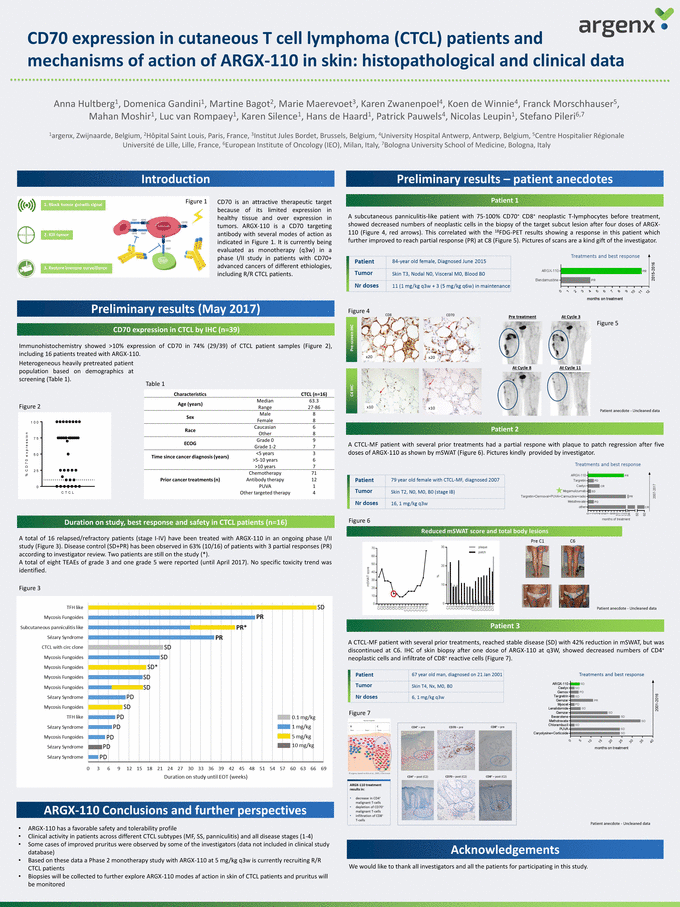- ARGX Dashboard
- Financials
- Filings
-
Holdings
- Transcripts
- ETFs
-
Insider
- Institutional
- Shorts
-
6-K Filing
argenx SE (ARGX) 6-KCurrent report (foreign)
Filed: 14 Jun 17, 12:00am
Exhibit 99.2
CD70 expression in cutaneous T cell lymphoma (CTCL) patients and mechanisms of action of ARGX-110 in skin: histopathological and clinical data Anna Hultberg1, Domenica Gandini1, Martine Bagot2, Marie Maerevoet3, Karen Zwanenpoel4, Koen de Winnie4, Franck Morschhauser5, Mahan Moshir1, Luc van Rompaey1, Karen Silence1, Hans de Haard1, Patrick Pauwels4, Nicolas Leupin1, Stefano Pileri6,7 1argenx, Zwijnaarde, Belgium, 2Hôpital Saint Louis, Paris, France, 3Institut Jules Bordet, Brussels, Belgium, 4University Hospital Antwerp, Antwerp, Belgium, 5Centre Hospitalier Régionale Université de Lille, Lille, France, 6European Institute of Oncology (IEO), Milan, Italy, 7Bologna University School of Medicine, Bologna, Italy Introduction Figure 1 Preliminary results – patient anecdotes Patient 1 CD70 is an attractive therapeutic target because of its limited expression in healthy tissue and over expression in tumors. ARGX-110 is a CD70 targeting antibody with several modes of action as indicated in Figure 1. It is currently being evaluated as monotherapy (q3w) in a phase I/II study in patients with CD70+ advanced cancers of different ethiologies, including R/R CTCL patients. A subcutaneous panniculitis-like patient with 75-100% CD70+ CD8+ neoplastic T-lymphocytes before treatment, showed decreased numbers of neoplastic cells in the biopsy of the target subcut lesion after four doses of ARGX-110 (Figure 4, red arrows). This correlated with the 18FDG-PET results showing a response in this patient which further improved to reach partial response (PR) at C8 (Figure 5). Pictures of scans are a kind gift of the investigator. Preliminary results (May 2017) CD70 expression in CTCL by IHC (n=39) Figure 4 Figure 5 Immunohistochemistry showed >10% expression of CD70 in 74% (29/39) of CTCL patient including 16 patients treated with ARGX-110. Heterogeneous heavily pretreated patient samples (Figure 2), population based on screening (Table 1). demographics at Table 1 Figure 2 Patient anecdote - Uncleaned data Patient 2 A CTCL-MF patient with several prior treatments had a partial respone with plaque to patch regression after five doses of ARGX-110 as shown by mSWAT (Figure 6). Pictures kindly provided by investigator. Figure 6 Duration on study, best response and safety in CTCL patients (n=16) A total of 16 relapsed/refractory patients (stage I-IV) have been treated with ARGX-110 in an ongoing phase I/II study (Figure 3). Disease control (SD+PR) has been observed in 63% (10/16) of patients with 3 partial responses (PR) according to investigator review. Two patients are still on the study (*). A total of eight TEAEs of grade 3 and one grade 5 were reported (until April 2017). No specific toxicity trend was identified. Figure 3 Patient anecdote - Uncleaned data Patient 3 A CTCL-MF patient with several prior treatments, reached stable disease (SD) with 42% reduction in mSWAT, but was discontinued at C6. IHC of skin biopsy after one dose of ARGX-110 at q3W, showed decreased numbers of CD4+ neoplastic cells and infiltrate of CD8+ reactive cells (Figure 7). Figure 7 ARGX-110 Conclusions and further perspectives ARGX-110 has a favorable safety and tolerability profile Clinical activity in patients across different CTCL subtypes (MF, SS, panniculitis) and all disease stages (1-4) Some cases of improved pruritus were observed by some of the investigators (data not included in clinical study database) Based on these data a Phase 2 monotherapy study with ARGX-110 at 5 mg/kg q3w is currently recruiting R/R CTCL patients Biopsies will be collected to further explore ARGX-110 modes af action in skin of CTCL patients and pruritus will be monitored Patient anecdote - Uncleaned data • • • Acknowledgements We would like to thank all investigators and all the patients for participating in this study. • • % CD70 expression 1007550250 CTCL Patient 84-year old female, Diagnosed June 2015 Tumor Skin T3, Nodal NO, Visceral MO, Blood BO Nr droses 11 (1 mg/kg q3w + 3 (5mg/kg q6w) in maintenance Patient 79-year old female with CTCL-MF, diagnosed 2007 Tumor Skin T2, NO, MO, BO (stage IB) Nr droses 16.1 mg/kg q3w Characteristics CTCL (n=16) Age (years) Median Range 63.3 27-86 Sex Male Female 8 8 Race Caucasian Other 6 8 ECOG Grade 0 Grade 1-2 9 7 Time since cancer diagnosis (years) <5 years >5-10 years >10 years 3 6 7 Prior cancer treatments (n) Chemotherapy Antibody therapy PUVA Other targeted therapy 71 12 1 4
